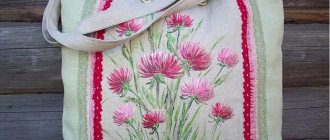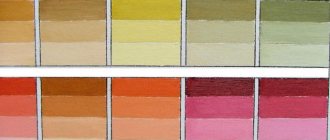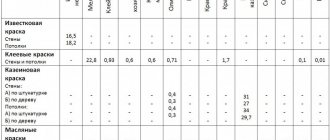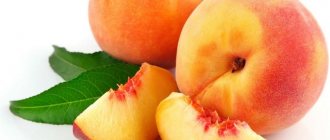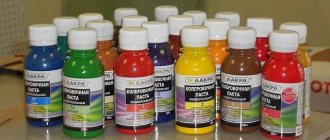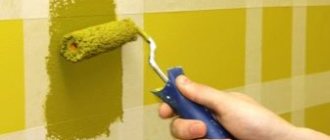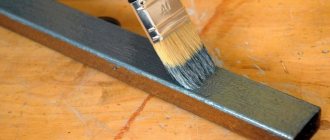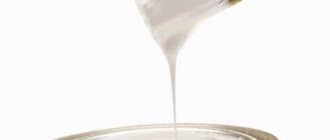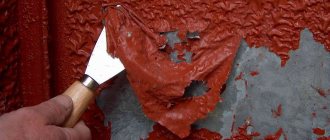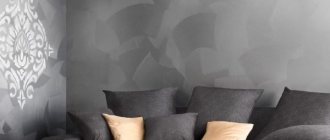The color for acrylic paint is usually selected when there is no ready-made material of the desired shade on sale. By correctly mixing a white base with one or more coloring compounds, you can get any, even the most complex, tone.
Working with color always involves some difficulties, so when starting to create an original shade, it is important to take into account some subtleties and professional techniques.
Main purpose
In English, “color” is translated as “color” or “tone.” In the chemical industry, this word is used as a term for dyes, with the help of which paints of the required shades are obtained. By varying the concentration of additives, you can obtain muted pastel tones or bright, saturated shades.
But that’s not all, tinting the paint can help make the new surface layer matte or glossy, pearlescent or copper. You can paint any substrate: wood, plasterboard, metal, chipboard, fiberboard.
Creating unique shades opens up enormous opportunities for the implementation of any design projects. The main thing is to choose the right pigment for each specific paint. To do this, you need to be able to understand the existing assortment.
Correct tinting allows you to get a matte or glossy color Source vkfaces.com
Independent work on obtaining the desired color
No special skills are required to perform tinting. Don’t be afraid to start work, even if you haven’t had this kind of practice before. Even a beginner can handle tinting. The only rule that we must adhere to if we mix colorant with paint with our own hands is to make as much material as is needed to paint the entire room, since, alas, it will not be possible to achieve a similar shade when mixing again, no matter how hard we try.
If you need to get a bright color, it is better to mix the paint immediately before starting work.
The technology for obtaining the required shade is quite simple. First, prepare a container into which we pour the required amount of white paint. We recommend buying paint from the same manufacturer, since each of them has its own composition, and the shade of white may differ. We measure out the required amount of color according to the instructions to obtain the desired result. It is preferable to mix the paint before starting work if we plan to get a bright color, since over time the colorant settles and the color becomes less bright. Constant stirring of the prepared mixture will help to cope with this.
For tinting, use snow-white paint to achieve the desired result. Using plain white paint can be very disappointing as it has a yellowish tint that can ruin the final look. To mix, use a drill with a mixer specially designed for paints. It is easy to distinguish it from others - all its elements have a rounded shape. We introduce the colorant gradually, first add only 2-3 drops and look at the result. If a more saturated color is needed, add one drop of color, continuously stirring the paint at low speed. We continue to do this until we are completely satisfied with the resulting color.
Types of colors
Manufacturers produce two types of colors. Some have a consistency similar to a thick paste (colorants). Others are sold as a liquid concentrated (intensive) solution. Each has its own area of use
Adding the paste to white paint allows you to get a dense, rich color. Mixing the base with the color in the form of a concentrated solution ensures the creation of soft pastel shades.
Today, intensive solutions are used more often than pastes. And all because manufacturers offer consumers a wide range of ready-made compositions for a wide variety of surfaces.
Dim tinting colors Source twoidvor.com
See also: Catalog of companies that specialize in finishing and paintwork materials and related work
Taking this into account, color additives are classified according to their intended purpose. On sale you can see the following colors:
- for compositions intended for wood processing;
- for bases prepared on the basis of aqueous dispersions;
- for enamels;
- for translucent varnishes, the use of which allows you to obtain surfaces with the effect of gold, silver, bronze, copper.
Very often, manufacturers produce their own series of colors for each type of paint. Builders prefer to buy just such a pair: it represents ideal compatibility. There are guarantees that after mixing the components, the finished solution will not curl, and the coating will not crack after drying.
It is better to choose paint and color from one manufacturer Source blogspot.com
How to choose the right shade
When choosing the right shade, certain factors should be taken into account. For example, you need to remember that the finished, painted surface may differ from the test strokes.
Lighting also affects color, so, for example, in bright lighting, rich shades will visually look lighter, and low lighting will make them gloomy and dull. Cool light gives the color a bluish tint, while warm light gives the color a yellowish tint.
Also, keep in mind that electronic color tables do not reflect actual color because the screen distorts them.
The choice of colors is influenced by the purpose of the room, so for the hallway and kitchen it is better to choose richer, richer colors, and for the bedroom pastel colors are more suitable.
- It is better to do manual tinting in the room that will subsequently be painted.
- This way, it will be easier to take into account all the features of the room, such as, for example, location, room size and lighting.
- In order to avoid getting different shades, it is necessary to dilute the dye in the paint in an amount sufficient for one room.
- The proportions of dye to coloring composition can be found on the packaging, but it is better to buy a little more dye than normal.
Features of choice
Creating paint of the desired color is a rather specific task, difficult for an inexperienced master. When solving it, existing standards cannot be ignored. They are expressed as percentages:
- In oil-based paints, the amount of color should not exceed 15%.
- In water-based paints, its share should not exceed 20%.
- In other types of base, the amount of color should not be more than 7%.
By choosing a paste, you can reduce the percentage of color and get a bright, rich tone. But liquid color for water-based paint is not able to provide intense coloring. The color after mixing with a white base always turns out muted. This must be taken into account when choosing the type of supplement.
New products appear on the market every year. Today the range includes colors for façade paints (they increase resistance to ultraviolet radiation and precipitation), there are special systems (for signal paints, for compositions intended for interior decoration of medical and educational institutions).
Signal (luminous) paints Source 2gis.com
It’s difficult to say unequivocally which is better: a paste or a concentrated solution. Each has its own specifics. It is related to the method of tinting the paint. It is more difficult to work with pastes: you have to independently, by trial and error, gradually add a small amount of color to the base composition, and in this way look for the desired color.
The use of ready-made solutions is much simpler: Each corresponds to a specific shade in the color atlas. You can, based on the map, select the desired tone and mix it with the basic white composition. After which the paint is completely ready for use.
Manual and computer tinting of paint
You can tint the paint in two ways: computer and manual. Painting a house will require the prior purchase of a base paint and a colorant set.
The pigment must be added right before you start painting. The ratios are selected in accordance with the conditions specified in the instructions.
Tinting paint with your own hands has a number of advantages:
- Opportunity to save a large amount of money;
- You can tint the paint directly on the site where the repair work is being carried out;
- Ability to create unique colors.
However, the tinting procedure, which is carried out at home, has the only drawback: it is impossible to re-display the resulting color. Computer tinting is controlled by a special program. The operator selects the color according to the instructions, and the program independently sets the proportions and then provides the finished composition.
The most popular additives are those that contain both types of pigments, which guarantees the desired saturation and also makes the finish more resistant to ultraviolet radiation.
Tinting methods
There are two ways to mix base paint with color: manually and using computer systems. Each method has its pros and cons.
When mixing by hand, the color is added to the paint in small portions, and the color is created “by eye.” You don’t need any complicated equipment for this, plus you can tint the paint anywhere. Accordingly, this method is good for preparing a small portion of paint that can be used immediately. This method is not suitable for mixing paints in large quantities and in several steps, since when creating subsequent portions it is almost impossible to achieve the original color.
Manual method of mixing color Source bauemotion.de
Specificity of pigments
Pigments according to their composition are divided into organic and inorganic. The use of an organic dye allows you to uniformly color the base without bald spots, but there are also disadvantages; organic dyes are extremely unstable to sunlight.
This coating is not durable and requires constant updating due to color fading.
- An inorganic color for acrylic paint does not fade when exposed to sunlight, but is significantly inferior in pigmentation to organic colors.
- It is best to use colors that contain both organic and inorganic dyes.
Briefly about the main thing
When paint colors began to be sold, they revolutionized the world of design. Builders have the opportunity to create a wide variety of coatings, paint interiors and exteriors in bright and delicate shades that can perfectly reveal the design concept.
Today, pastes and concentrated solutions are used for these purposes. The former are more suitable for coloring base compositions using computer systems. The second is for manual mixing of paints.
Ratings 0
Compositions
There are several types of tinted substance.
- Paint (this composition must fully correspond to the paint and varnish material used).
- Paste (implies ease of use, allowing you to adjust the shade when mixing).
- Dry composition (the most affordable, the only disadvantage is the limited range of colors).
To create, dilute and obtain the correct tone for uniform coloring of the plane, you need to take tinting paint. This type of paint is created by mixing the main base shades with a coloring element - color.
What to consider during the coloring process
The process of tinting paint to obtain the desired color does not look complicated if you follow a certain sequence of work. In practice it looks something like this:
- Take small jars made of plastic or glass. All containers, as well as working hands and arms, must be clean.
- The paint base is poured into one container and its volume is recorded on paper. Then add a few drops of color, also reflecting the data on paper.
- The mixture is thoroughly mixed until the paint acquires a uniform color. To begin with, add no more than three drops, then add one more until the desired tone is obtained.
- After obtaining the desired shade, it must be applied to the surface to be painted and it is better to paint a square measuring 40 by 40 centimeters as a sample. A day later, after the paint has completely dried, you should evaluate the result in electric and natural light. The color in the jar is usually duller than on the surface.
- If you are satisfied with the resulting tone, then you can begin preparing all the material. 20% should be subtracted from the estimated amount of color when calculating proportions. This is due to the fact that on a small square the paint will look duller than on a large area where it will look brighter.
How to properly paint surfaces with water-based paint
All preparatory work can be in vain if the material is applied incorrectly to the surface. Water-based paint can be used to paint concrete, brick, plaster, drywall and other similar materials. If you follow all the simple rules, the paint will last a long time. Before painting, you should remove all furniture from the room or cover it with film. This is due to the fairly liquid consistency of the paint. Before painting the surface, it is necessary to carry out thorough preparation: remove peeling coatings, plaster if necessary, wash off the old whitewash.
Smooth walls that have old water-based paint should be thoroughly wiped off dust and dried. To prevent old cracks from standing out after painting, they should be sealed with putty. All drips and stains on the old surface must be painted over with oil paint that matches the color of the paint.
All metal parts that may appear on the surface to be painted must also be coated with oil paint. It is better to take oil paint a tone lighter than the main color for painting the surface.
Before painting, the surface after treatment should be coated with a primer. This is necessary for better adhesion of the paint to the surface being painted, as well as for protection from moisture, which will extend its service life. After priming, it lays down in a more even layer, which helps reduce material consumption.
Acrylic primer goes perfectly with this type of paint. You can apply the finished paint to the surface either with a paint roller or brush, or with a spray gun. When using a spray gun, do not forget about purchasing a respirator.
When applying with a roller, you should purchase a special tray that will help remove all excess. Apply it with vertical movements. Start painting the room from the farthest corner from the entrance. This material will have to be applied to the surface in several layers. Re-painting should not be carried out earlier than four hours after applying the first layer. The application of paint with a roller to the wall surface can be seen in the photo.
Machine
Machine mixing of paint and varnish material is controlled by a computer using a standard type of recipe contained in the program. If necessary, you can re-get an identical color.
The advantages of computer tinting include:
- accuracy and speed of the process;
- re-obtaining the desired shade;
- correct selection of paint when creating a dark shade;
- wide range of resulting tones.
Minuses:
- the impossibility of carrying out tinting directly on the construction site;
- inability to create complex shades;
- quite high cost.
For more information about tinting paint, see the following video.
Many buyers search for the appropriate color because ready-made acrylic paint is not available in the desired shade or buyers need a special color. Today on the market you can find a lot of different color options from both domestic and foreign manufacturers. However, before making a purchase, it is very important to know the subtleties of choosing a particular color for acrylic enamel.

